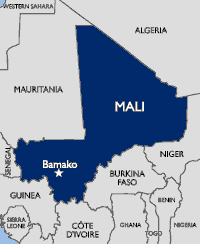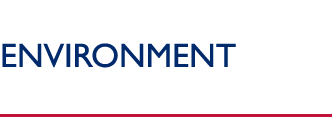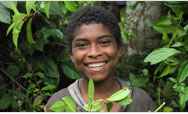Mali
USAID’s climate change activities in Mali support improved natural resource management through sustainable agriculture, training in water use efficiency, and community awareness campaigns.
Background

A landlocked Sahelian country with a per capita income of $405 per annum and a population of 13 million, Mali has an agriculture-based economy in which cotton, livestock, and cereals predominate. In the last few years, gold is taking an important place in the economy. Much of Mali’s population is dependent on rain-fed agriculture for food; however, the rainfall is variable and is affecting the country’s fragile natural resource base. USAID is working to diversify agriculture to help reduce risk and preserve the environment.
Sector-Specific Climate Change Activities
Particularly addressing economic opportunities through agriculture, USAID is working in Mali to improve natural resource management as well as rural incomes through implementation of sustainable agricultural practices and protection of natural resources. Protecting natural resources such as forests, for example, is beneficial to the climate because forests remove carbon dioxide from the atmosphere and store carbon both above ground in their biomass and in the soils below. USAID helps protect Mali’s resources against further environmental degradation by building local capacity to manage forest and agricultural resources in a more sustainable manner.
In the upper valley of the Niger River in Mali, USAID has successfully promoted agricultural and natural resource management practices that have reduced soil erosion, improved water use management, and promoted effective land use planning. These initiatives have increased crop yields for farmers while increasing carbon sequestration. As a result of the Upper Niger River Valley program (OHVN, “Office de la Haute Vallée du Niger”), a number of communities have measurably stabilized or even increased vegetation cover on their lands, resulting in higher levels of soil carbon storage.
Amending soils with organic matter has become a crop production management tool for thousands of farmers in the program area. The program demonstrated that soils with higher rates of organic matter increased fertilizer-use efficiency and increased retention of soil moisture, and particularly reduced land erosion when rock lines practices are used simultaneously. In this manner some farmers were able to recuperate abandoned crop fields. Almost 9,000 farmers have benefited from training in integrated soil fertility management. The combined effect has been higher yields and lower risk. The composting technologies that were introduced by OHVN reduced the danger of weeds and disease while increasing the positive effects of organic matter. A side benefit of this type of agricultural intensification, which builds the productive capacity of the soil and increases yields, is that farmers are able to stabilize their production areas instead of continually clearing new lands – the end result is that less carbon is released into the atmosphere.
The program has been very successful at implementing micro-irrigation technologies as well, which are especially popular among women gardeners because of their low operating cost, time saving benefits, and income generating potential. One particular intervention through Enterprise Works World Wide (EWW) led to the adoption of foot pumps that have been used in vegetable gardens, fruit orchards, arboriculture, and rice nurseries. From a climate change perspective, water efficiency ultimately translates into energy efficiency and reduced carbon emissions.
In support of natural resources management, twenty communes have developed land use management plans with support from the program. Communities have been empowered to collaborate with forestry agents from the Malian government and its local non governmental organization (NGO) partners to determine their highest priorities. They then create community based structures to manage implementation and enforcement processes. In one innovative example, seven communities constructed over three kilometers of rock lines to protect and preserve fragile, low-lying inland valley watersheds.
Past USAID funded programs have increased forest cover through policy reform and improved forestry management. In the early 1990s, OHVN-supported villages in the Oueléssébougou region south of Bamako negotiated with the Malian Forestry Service to end commercialization of fuelwood from village lands by Bamako-based merchants. The quid pro quo was that communities could only cut wood for their own use and could no longer sell it. Several of these communities went farther than halting commercial cutting, developing bylaws that encouraged people to use only deadwood for fuel and to let some areas grow; others organized themselves into groups to watch for illegal cutting and to restore vegetation on hillsides that were the source of floodwaters. The results of these initiatives are measurable. U.S. Geological Survey scientists compared the forest cover in nine communities at three time periods over the last 30 years. They found that in all but two cases, the rate of forest cover decline is less since the late 1980s, and in two cases, there was more cover today than in the 1980s.
An assessment of OHVN results revealed principles that would likely have application beyond the program area and in other countries for increasing the number of people who invest in technologies that increase carbon sequestration. Common to all people in the OHVN program area who invested in soil carbon or forest land management was a link to livelihoods. The farmers saw a direct link between soil carbon levels and productivity. Community members who protected community forest lands talked in terms of increased ground water, less erosion, expanded source of pharmacopoeia and game, and more reliable sources of fuel wood.
In addition, USAID has helped to reduce deforestation by lowering the demand for wood as a fuel source. It has supported EWW in the design, production, and adoption activities of fuel-efficient wood stoves, which have resulted in significant reductions in carbon dioxide emissions. Thousands of hectares of forest area have been saved by these activities, and thousands more are expected to be preserved in the future.
Project Highlight
Raising Awareness: In 2007, radio programs were broadcasted to communities around Koulikoro City, focusing on the causal agents of global climate change and its negative impacts on the environment. Topics included deforestation, greenhouse gases, pesticides, and water pollution.
Partners
USAID’s partners in climate change activities in Mali include:
- Abt. Associates
- AED (Global Sustainable Tourism Alliance)
- Agricultural School of Katibougouo (IPR)
- Institute d’Economic Rural (IER)
- Mali Ministry of Agriculture, Livestock and Fisheries
- Mali Ministry of Environment
- Radio Jamana/Koulikoro
Because partners change as new activities arise, this list of partners is not comprehensive.
Back to Top ^
|


